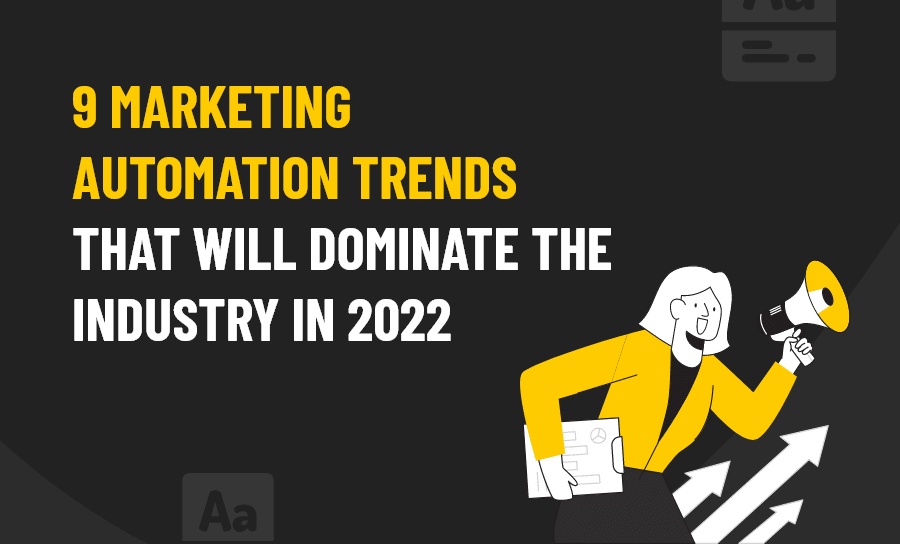The Future of Marketing Automation and How You Can Be Future-ready (as a Marketer)
What is Marketing Automation? How Does it Work?
Marketing automation is a platform that helps you manage your customer relationships better. It lets you engage your prospects and customers at the right time to create new opportunities, quickly follow up on past leads, and qualify new prospects to keep your pipeline full.
Whether a startup or a large enterprise, marketing automation software is essential to growing your business. It is more than an email tool that helps in lead generation.
Check out these marketing automation examples of how they can help your business!
- It creates a customer journey by defining and refining the process from prospect to repeat purchaser. It keeps track of all the little tasks you might forget to do, leading to more conversions in the long run.
- Marketers can also help customers get through an easy email verification process, create personalized email campaigns, nurture leads in specific stages of the buyer journey, track key metrics and optimize their lead funnel using marketing automation software.
There’s more! Marketing automation gives B2B companies the tools to reach and engage prospects with everything, including:
- Email marketing
- Social media marketing
- Lead nurturing
- Inbound marketing
- Digital advertising
- Landing pages and forms
9 Marketing Automation Trends That Will Dominate the Industry in 2023
1. Use of behavioral data for hyper-personalized marketing
2. Accelerated use of funnel-optimized content
Personalization is a practical approach to boosting customer experience. However, using names and location data is only the initial step in delivering a personalized experience.
Hyper-personalization takes personalization up a notch by using real-time behavioral data of your customers across the entire buying funnel. For example, sending offers and coupons at different stages of the purchase process, as well as providing relevant product recommendations.
Some hyper-personalized strategies you can try in 2023:
- Account-based marketing (ABM): ABM is a popular phrase that refers to an approach to marketing. It means “targeting accounts” instead of focusing on “attracting the general audience” or “filtering them down by lead scoring.” You can then send personalized content to potential clients who are “likely to be a lead.”
- Milestone emails: Milestone emails are different from welcome emails. Welcome emails are sent to everyone who has signed up for your email list. On the other hand, milestone emails are sent to active subscribers who have completed a purchase or upgraded to a paid plan.
3. Machine learning (ML) and artificial intelligence (AI) will continue to take charge
If you’re stuck implementing personalization, don’t give up. 63% of digital marketing leaders experience the same thing. However, 17% see positive results from using AI and machine learning tools to take on personalization, so it’s worth a shot!
Gartner’s research shows that organizations that focus on creating a personalized experience in which customers are consistently recognized, even across multiple channels, are likely to increase business performance.
The future of marketing automation has machine learning all over it. Machine learning allows you to combine multiple data points and obtain an aggregate result that is – more often than not – a lot more accurate. By using these tools, you can also customize your customers’ experience in a much more timely fashion. This enables you to generate more leads at a much lower cost.
Other capabilities of machine learning include:
- Deliver real-time responses: Marketing automation platforms offer predictive capabilities. These tools can be used to determine the optimal time for reaching out to different types of buyers based on what they have done in the past. It becomes possible thanks to the pattern recognition of artificial intelligence.
- Identify micro-segments of customers: Machine learning allows you to see patterns faster. Using ML, you can identify small groups of customers who share similar interests rather than lumping them all together in one segment.
- Evaluate underlying patterns: Sometimes, conventional wisdom turns out to be overblown. Machine learning (ML) can help you find underlying patterns that could point to a new approach or an emerging trend. It can also offer prescriptive advice so that you can examine problems like bounce rate and irrelevant traffic from a new perspective.
Marketing automation and machine learning are two of the most exciting growth areas in the marketing industry. They’re changing how marketers interact with customers, grow leads, and increase sales. They will only get better in the future, allowing you to engage with the right audience at the right time.
4. Automation in content marketing will create more opportunities.
Are you using marketing automation in your content marketing? If not, you should be!
It’s time to jump on board the content marketing automation train. While it’s been available for some time, the demand for content is creating a new breed of consumers for automated marketing.
What your content means remains important to your customers and prospects. And developing campaigns that deliver relevant content to the right person at the right time is a massive opportunity for your efforts.
With new tools and reports in your arsenal, you can personalize interactions and add a human touch to your campaigns. You can even make sure every interaction your business has with prospects and customers is a deliberate one.
The end result: Your business will get more leads, more conversions, and a better return on investment (ROI).
5. The rapid adoption of mobile-first automation
The mobile market is already the largest and most lucrative in tech, and it’s only getting bigger. According to a report, 71% of millennials are even open to allowing service providers to use their smartphone data for personalization. No wonder the best way to connect with your target audience in 2023 is through mobile – it’s instant, personal, and portable.
What does it mean for you? First of all – improve your mobile websites for easier shopping. This means, maybe, you can rebuild your landing page so that it is responsive and flexible enough to cater to the mobile display.
You can use various marketing tools to get more people to sign up and engage with your product, including push notifications, in-app ads, SMS, and email.
6. Chatbots will continue to make headlines.
Chatbots are artificial intelligence programs that use machine learning to simulate interactive human conversations. As the demand for intelligent chatbots has grown, many companies have started using them in addition to their customer service software to communicate with customers. They help improve customer experience on websites, social media apps, such as Facebook Messenger and WhatsApp, and even business helpdesks.
At first, chatbots were set up with responses to common customer questions. However, many consumers are becoming wary of these robotic conversations. The rise of artificial intelligence and machine learning has enabled the creation of chatbots with the ability to modify their responses based on a person’s behaviour and other demographics. This has created a need for chatbots with more human-like conversations.
What started simply as a marketing tool has now become the ultimate online engagement tool. These days, chatbots take care of customer support and appointment settings, among others. It is evident that these robots will continue making headlines in 2023 and beyond.
We may have chatbots handling the entire sales process in the coming day and we won’t have to opt for Sales Outsourcing to gain a competitive advantage.
7. Augmented reality is here to stay.
Because the pandemic is not going away (at least not anytime soon), brands are eager to keep operations going and make the most of this situation. Augmented reality provides a convenient and efficient way for them to do so.
Augmented Reality (AR) is already an age-old concept that has been used for gaming, architecture, and movies. Big brands are now using AR to allow consumers to experience their products without the need to try them in person by using AR-based apps.
Augmented reality is a technology that allows customers to interact with products and services by viewing them through their mobile devices. AR can be used for the benefit of eCommerce, among other places, to simulate the experience of choosing items in a grocery store or trying on new sunglasses. The process helps customers visualize the product, which allows them to make an informed decision.
As mentioned, it is a great alternative for those who are unable to access physical stores because of the pandemic. Mix it up with marketing automation, preferably in the decision stage of your sales funnel for even better sales.
8. Social media automation will be at its peak.
Automating your social media campaign is something that was done frequently in the past. Back then, there wasn’t any other way to do it (yes, some tools did exist, but they were nowhere near as efficient).
Today, however, things have changed dramatically. You can now not only automate your interactions using services such as Buffer and Hootsuite — but also with social listening tools such as Mention and Google Alerts. You can also automate Shopify to Google Sheets integration.
While there’s no single tool you can use that will cover all your social media marketing needs (it’s what makes social media special), a social media analytics dashboard enables you to see all your social media performance in one place.
As more businesses are pushed to leverage social media, there will be more and more platforms for them to choose and mark the future of marketing automation.
9. Continued omnichannel experience
You might have seen the same ads multiple times on Instagram or Facebook, and you might have even seen them on different platforms. You might also see their banners or posts in your inbox.
This is what marketing automation allows you to do: It follows a customer around and helps brands retarget customers in an omnichannel fashion.
It is an effective way of managing content and sending marketing messages based on where the customer is in their journey, resulting in a better overall user experience. Marketing automation allows companies to upload content or marketing ads to several channels at the same time.
As more marketers begin to see the value of omnichannel campaigns, the need for tools that facilitate such marketing efforts will increase. Marketers will not only want a marketing automation platform that works across channels but also one that is able to expand as their needs change.
Thankfully, there are a lot of options for marketing automation tools, so it won’t be too hard for you to find your ideal suite to help you get going.





